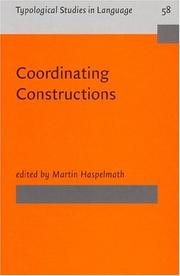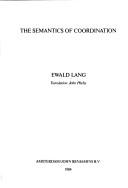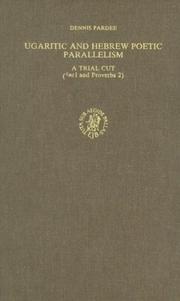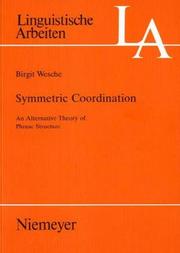| Listing 1 - 9 of 9 |
Sort by
|
Book
ISBN: 9781905125418 1905125410 1910589233 Year: 2010 Publisher: Swansea : Oakville, CT : Classical Press of Wales ; Distributor in the US: The David Brown Book Co.,
Abstract | Keywords | Export | Availability | Bookmark
 Loading...
Loading...Choose an application
- Reference Manager
- EndNote
- RefWorks (Direct export to RefWorks)
Parallelism (Linguistics) --- Parallélisme (Linguistique) --- Plutarch. --- Plutarch --- Criticism and interpretation. --- Greece --- Rome --- Grèce --- Biography --- History and criticism. --- Biographie --- Histoire et critique --- Biographies --- Biography as a literary form. --- Parallelism (Linguistics). --- Parallélisme (Linguistique) --- Grèce
Book
ISBN: 9783110293487 9783110295290 Year: 2013 Volume: 21 Publisher: Berlin De Gruyter Mouton
Abstract | Keywords | Export | Availability | Bookmark
 Loading...
Loading...Choose an application
- Reference Manager
- EndNote
- RefWorks (Direct export to RefWorks)
Philosophical anthropology --- Theory of knowledge --- Psycholinguistics --- Creativity (Linguistics) --- Cognitive grammar --- Grammar, Comparative and general --- Coordinate constructions --- Coordination (Linguistics) --- Parallelism (Linguistics) --- Creative ability (Linguistics) --- Linguistic creativity --- Competence and performance (Linguistics) --- Linguistics --- Cognitive linguistics --- Syntax --- Philology

ISBN: 902722966X 1588114791 9786612254390 1282254391 9027295247 1423761340 9781423761341 9781588114792 9789027229663 Year: 2004 Volume: 58 Publisher: Amsterdam Benjamins
Abstract | Keywords | Export | Availability | Bookmark
 Loading...
Loading...Choose an application
- Reference Manager
- EndNote
- RefWorks (Direct export to RefWorks)
1.Introduction 2. NP conjunction 2.1 The main pattern: ʔił-conjunction 2.2 Other functions of ʔił 2.3 No other formal markers of NP conjunction 3. Clause conjunction 3.1 The main pattern: ts'eʔ-conjunction 3.2 Other functions of ts'eʔ 3.3 Other formal devices of clause conjunction 4. Disjunction 5. Adversative coordination 6. Conclusions.
Comparative linguistics --- Grammar --- Contrastive linguistics --- Grammar, Comparative and general --- Typology (Linguistics) --- Language and languages --- Linguistic typology --- Linguistics --- Linguistic universals --- Coordination (Linguistics) --- Parallelism (Linguistics) --- Coordinate constructions --- Typology --- Classification --- Syntax --- Philology --- Contrastive linguistics. --- LANGUAGE ARTS & DISCIPLINES --- Linguistics / General --- Coordinate constructions.
Book
ISBN: 8822237218 Year: 1990 Volume: 48 Publisher: Firenze Olschki
Abstract | Keywords | Export | Availability | Bookmark
 Loading...
Loading...Choose an application
- Reference Manager
- EndNote
- RefWorks (Direct export to RefWorks)
Language and languages --- Parallelism (Linguistics) --- Terms and phrases --- Stylistique --- Parallélisme (Linguistique) --- Terminologie --- Style --- Italian language --- -Italian literature --- -Ottovolante (Group of writers) --- Romance languages --- Idioms --- -History --- History and criticism --- -Idioms --- Parallélisme (Linguistique) --- Italian literature --- Idioms&delete& --- History

ISBN: 9786613222503 9027283141 1283222507 9789027283146 9781283222501 9027230080 9789027230089 9027230080 9789027230089 Year: 1984 Publisher: Amsterdam Benjamins
Abstract | Keywords | Export | Availability | Bookmark
 Loading...
Loading...Choose an application
- Reference Manager
- EndNote
- RefWorks (Direct export to RefWorks)
This study is an attempt to explain coordinate conjoining as a rule-governed process of establishing specific semantic relations within and between sentences. Coordination is thus conceived of both as a basic device of linguistic complex formation and as a rather fundamental principle underlying the creation of the text. From the point of view of achieving coherence, coordinate conjoining is described in this monograph as an integrative process. Described are the conditions governing this process, the rules according to which take place, in short: the complex interaction of various linguistica
Grammar, Comparative and general --- Semantics. --- Formal semantics --- Semasiology --- Semiology (Semantics) --- Comparative linguistics --- Information theory --- Language and languages --- Lexicology --- Meaning (Psychology) --- Coordination (Linguistics) --- Parallelism (Linguistics) --- Coordinate constructions. --- Syntax --- Semantics --- Coordinate constructions --- Lexicology. Semantics --- Grammar --- Coordination [Linguistique]. --- Nevenschikking [Taalwetenschap]. --- Linguistics --- Philology
Book
ISBN: 9789027206985 9789027265975 9027265976 9027206988 Year: 2017 Volume: 117 Publisher: Amsterdam John Benjamins Publishing Company
Abstract | Keywords | Export | Availability | Bookmark
 Loading...
Loading...Choose an application
- Reference Manager
- EndNote
- RefWorks (Direct export to RefWorks)
Back cover: "While comparative constructions have been extensively studied in the past decades, the expression of equality and similarity has so far attracted little attention in the typological literature. The fifteen contributions assembled in this volume study similative and equative constructions in typologically and genetically distant languages, albeit with a focus on Africa, and from a range of perspectives. Purely synchronically oriented case studies are supplemented by contributions that also shed light on the diachronic development of similative and equative constructions in language contact situations. Sources of similative morphemes and lexically expressed concepts of likeness are examined, and little-known multifunctionality patterns and grammaticalisation targets of similative morphemes - such as purpose clause markers, modality morphemes and markers of glottonyms - are discussed. Based on a sample of 119 languages worldwide, a new typology of equative constructions is proposed. The book should be of interest to typologists, semanticists, specialists of grammaticalization, historical linguistics and syntax".
Grammar, Comparative and general --- Contrastive linguistics. --- Typology (Linguistics) --- Language and languages --- Linguistic typology --- Linguistics --- Linguistic universals --- Grammaticalization --- Semantics --- Coordination (Linguistics) --- Parallelism (Linguistics) --- Coordinate constructions. --- Grammaticalization. --- Typology --- Classification --- Syntax --- Grammar --- Comparative linguistics --- Contrastive linguistics --- Coordinate constructions --- Grammar, Comparative and general - Coordinate constructions --- Grammar, Comparative and general - Grammaticalization
Book
ISBN: 9783110443066 3110443066 3110443570 3110435314 Year: 2015 Volume: 561 Publisher: Berlin ; Boston : de Gruyter Mouton,
Abstract | Keywords | Export | Availability | Bookmark
 Loading...
Loading...Choose an application
- Reference Manager
- EndNote
- RefWorks (Direct export to RefWorks)
This monograph explores the different types of clausal relations in the world's languages. In the recent literature, there have been claims that the strict dichotomy of subordination and coordination cannot be maintained since some constructions seem to be in between these two categories. This study investigates these constructions in detail. The first part is concerned with clause chaining constructions, while the second is concerned with different cases of asymmetric coordination in English. In both parts, it is shown that the different tests to distinguish clausal relations indeed yield different results for the specific constructions. This poses a severe challenge for the established theories of clausal relations. However, as it is argued, recent analyses of coordination provide for the possibility to map a subordinate structure onto a coordinate one by means of regular transformational rules. It is shown that a single movement step derives all the peculiar properties of the phenomena in question. This book thus provides the first comprehensive solution for a long-standing problem in theoretical syntax.
Minimalist theory (Linguistics) --- Grammar, Comparative and general --- Generative grammar. --- Grammar, Generative --- Grammar, Transformational --- Grammar, Transformational generative --- Transformational generative grammar --- Transformational grammar --- Psycholinguistics --- Coordination (Linguistics) --- Parallelism (Linguistics) --- Clauses --- Generative grammar --- Clauses. --- Coordinate constructions. --- Derivation --- Syntax --- Sentences --- Linguistics --- Philology --- Clausal Relation. --- Coordination, Minimalist Framework. --- Subordination. --- Fachpublikum/ Wissenschaft --- Clausal Relation; Subordination; Coordination, Minimalist Framework --- 1561: Hardcover, Softcover / Allgemeine und Vergleichende Sprachwissenschaft

ISSN: 00835889 ISBN: 9004083685 9004275622 9789004083684 Year: 1988 Volume: 39
Abstract | Keywords | Export | Availability | Bookmark
 Loading...
Loading...Choose an application
- Reference Manager
- EndNote
- RefWorks (Direct export to RefWorks)
Ugaritic language --- Ugaritic literature --- Parallelism. --- Relation to the Old Testament. --- 809.25 --- 221.02*1 --- -Ugaritic literature --- -Semitic languages, Northwest --- Ugaritisch --- Oud Testament: bijbelse filologie: hebreeuws --- Parallelism --- Relation to the Old Testament --- -Ugaritisch --- 221.02*1 Oud Testament: bijbelse filologie: hebreeuws --- 809.25 Ugaritisch --- -221.02*1 Oud Testament: bijbelse filologie: hebreeuws --- Semitic languages, Northwest --- Bible. --- Language, style. --- Bible. O.T. Proverbs II --- Language, style --- Parallelism (Linguistics) --- Bible --- O.T --- Proverbs II --- Ugaritic language - Parallelism. --- Ugaritic literature - Relation to the Old Testament.

ISBN: 311093468X 3484303328 3111867226 9783110934687 9783484303324 Year: 1995 Volume: 332 Publisher: Tübingen Niemeyer
Abstract | Keywords | Export | Availability | Bookmark
 Loading...
Loading...Choose an application
- Reference Manager
- EndNote
- RefWorks (Direct export to RefWorks)
Hitherto, the three symmetric coordination types Phrasal Coordination, Right Node Raising, and Gapping have been mostly treated in isolation. This book presents a successful attempt at developing a uniform approach - couched in a transformational framework, but also applicable to other grammatical approaches. But the account not only provides a common frame for coordination. In effect, it does away with the strict distinction between simplex and coordinate structures. The proposed approach - based on a natural extension to the classical X-scheme - is equally valid for both simplex and coordinate structures, and, thus, it presents a significant contribution to grammars of phrasal structures in general.
Grammar, Comparative and general --- Phrase structure grammar. --- Generative grammar. --- German language --- Coordinate constructions. --- Grammar, Generative. --- Grammar --- Generative grammar --- -German language --- -Grammar, Comparative and general --- -Phrase structure grammar --- Constituent structure grammar --- Grammar, Phrase structure --- Grammar, Generative --- Grammar, Transformational --- Grammar, Transformational generative --- Transformational generative grammar --- Transformational grammar --- Psycholinguistics --- Comparative grammar --- Grammar, Philosophical --- Grammar, Universal --- Language and languages --- Philosophical grammar --- Linguistics --- Philology --- Ashkenazic German language --- Hochdeutsch --- Judaeo-German language (German) --- Judendeutsch language --- Judeo-German language (German) --- Jüdisch-Deutsch language --- Jüdischdeutsch language --- Germanic languages --- Coordinate constructions --- Derivation --- Grammar, Comparative --- Coordination (Linguistics) --- Parallelism (Linguistics) --- Syntax --- Phrase structure grammar --- Grammar [Comparative and general ] --- Grammaire comparée et générale --- Syntaxe
| Listing 1 - 9 of 9 |
Sort by
|

 Search
Search Feedback
Feedback About UniCat
About UniCat  Help
Help News
News